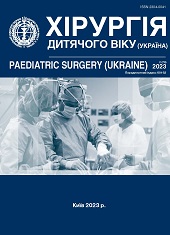Tacrolimus-associated sinus obstruction syndrome after liver transplantation from a living related donor
DOI:
https://doi.org/10.15574/PS.2023.79.99Keywords:
sinusoidal obstruction syndrome (SOS), tacrolimus, liver transplantationAbstract
Sinusoidal obstruction syndrome (SOS), previously known as hepatic veno-occlusive disease, is manifested by obliterating inflammation of the terminal hepatic veins, characterized by hepatomegaly, right upper quadrant pain, jaundice and ascites, and most often occurs in patients after hematopoietic stem cell transplantation and usually in those who received platinum drugs. Cases of SOS development in patients after transplantation of solid organs (lungs, pancreas, liver) are also recorded in the world literature. Cases of the development of SOS after transplantation of solid organs are rare, and after transplantation of the liver lobe from a living family donor - isolated and poorly studied. The diagnosis is established on the basis of clinical signs, imaging techniques (according to ultrasound and radiological research methods), histological study of a liver biopsy. Tacrolimus has been reported to be a causative agent that potentially plays a role in the pathophysiological mechanism of SOS.
Purpose - to study the relationship between prolonged-release tacrolimus and the development of sinusoidal obstruction syndrome in patients after living donor liver transplantation.
Clinical case. In this article, we present a case of SOS after living donor liver transplantation, which was associated with the toxic effect of prolonged-release tacrolimus («Envarsus»). In a 55-year-old man, after living donor liver transplantation, high concentrations of tacrolimus in the blood associated with uncontrolled drug intake were recorded. When carrying out a number of laboratory and instrumental research methods in connection with the appearance of massive ascites, the diagnosis of SOS was established. After excluding other possible contributing factors, including an acute rejection crisis, it was concluded that long-acting tacrolimus («Envarsus») was the cause of SOS.
The research was carried out in accordance with the principles of the Helsinki Declaration. The informed consent of the patient was obtained for conducting the studies.
No conflict of interests was declared by the authors.
References
Fan CQ, Crawford JM. (2014). Sinusoidal Obstruction Syndrome (Hepatic Veno-Occlusive Disease). Journal of Clinical and Experimental Hepatology. 4; 4: 332-346. ISSN 0973-6883. https://doi.org/10.1016/j.jceh.2014.10.002; PMid:25755580 PMCid:PMC4298625
Jiang JY, Fu Y, Ou YJ, Zhang LD. (2022, Dec 26). Hepatic sinusoidal obstruction syndrome induced by tacrolimus following liver transplantation: Three case reports. World J Clin Cases. 10 (36): 13408-13417. https://doi.org/10.12998/wjcc.v10.i36.13408; PMid:36683644 PMCid:PMC9851010
Kernan NA, Grupp S, Smith AR et al. (2018). Final results from a defibrotide treatment-IND study for patients with hepatic veno-occlusive disease/sinusoidal obstruction syndrome. Br J Haematol. 181 (6): 816-827. https://doi.org/10.1111/bjh.15267; PMid:29767845 PMCid:PMC6032999
Li C, Ma H, Sun C. (2022). Hepatic Sinusoidal Obstruction Syndrome Post-Liver Transplantation: A Rare Complication of Tacrolimus. Clin Gastroenterol Hepatol. 20: e347. https://doi.org/10.1016/j.cgh.2020.08.049; PMid:32858201
Nauffal M, Kim HT, Richardson PG, Soiffer RJ, Antin JH, Cutler C et al. (2022, Jan 11). Defibrotide: real-world management of veno-occlusive disease/sinusoidal obstructive syndrome after stem cell transplant. Blood Adv. 6 (1): 181-188. https://doi.org/10.1182/bloodadvances.2021005410; PMid:34666352 PMCid:PMC8753224
Ruiz-Manriquez J, Kauffman-Ortega E, Gamboa-Dominguez A, Ríos-Valencia J, Ramirez-Quesada W, C Flores-García N. (2021). Sinusoidal obstruction syndrome after liver transplantation: An interplay between thrombotic and immunological factors. A case report, Journal of Liver Transplantation. 2: 100018. ISSN 2666-9676. https://doi.org/10.1016/j.liver.2021.100018
Sebagh M, Azoulay D, Roche B, Hoti E, Karam V, Teicher E et al. (2011). Significance of isolated hepatic veno-occlusive disease/sinusoidal obstruction syndrome after liver transplantation. Liver Transpl. 17: 798-808. https://doi.org/10.1002/lt.22282; PMid:21351239
Shen T, Feng XW, Geng L, Zheng SS. (2015, May 28). Reversible sinusoidal obstruction syndrome associated with tacrolimus following liver transplantation. World J Gastroenterol. 21 (20): 6422-6426. https://doi.org/10.3748/wjg.v21.i20.6422; PMid:26034381 PMCid:PMC4445123
Shin NY, Kim MJ, Lim JS, Park MS, Chung YE, Choi JY, Kim KW, Park YN. (2012, Apr). Accuracy of gadoxetic acid-enhanced magnetic resonance imaging for the diagnosis of sinusoidal obstruction syndrome in patients with chemotherapy-treated colorectal liver metastases. Eur Radiol. 22 (4): 864-871. https://doi.org/10.1007/s00330-011-2333-x; PMid:22108766
Starzl TE, Porter KA, Mazzaferro V, Todo S, Fung J, Francavilla A. (1991, Jan). Hepatotrophic effects of FK506 in dogs. Transplantation. 51 (1): 67-70. https://doi.org/10.1097/00007890-199101000-00010; PMid:1702912 PMCid:PMC2967279
Downloads
Published
Issue
Section
License
Copyright (c) 2023 Paediatric Surgery (Ukraine)

This work is licensed under a Creative Commons Attribution-NonCommercial 4.0 International License.
The policy of the Journal “PAEDIATRIC SURGERY. UKRAINE” is compatible with the vast majority of funders' of open access and self-archiving policies. The journal provides immediate open access route being convinced that everyone – not only scientists - can benefit from research results, and publishes articles exclusively under open access distribution, with a Creative Commons Attribution-Noncommercial 4.0 international license(СС BY-NC).
Authors transfer the copyright to the Journal “PAEDIATRIC SURGERY.UKRAINE” when the manuscript is accepted for publication. Authors declare that this manuscript has not been published nor is under simultaneous consideration for publication elsewhere. After publication, the articles become freely available on-line to the public.
Readers have the right to use, distribute, and reproduce articles in any medium, provided the articles and the journal are properly cited.
The use of published materials for commercial purposes is strongly prohibited.

